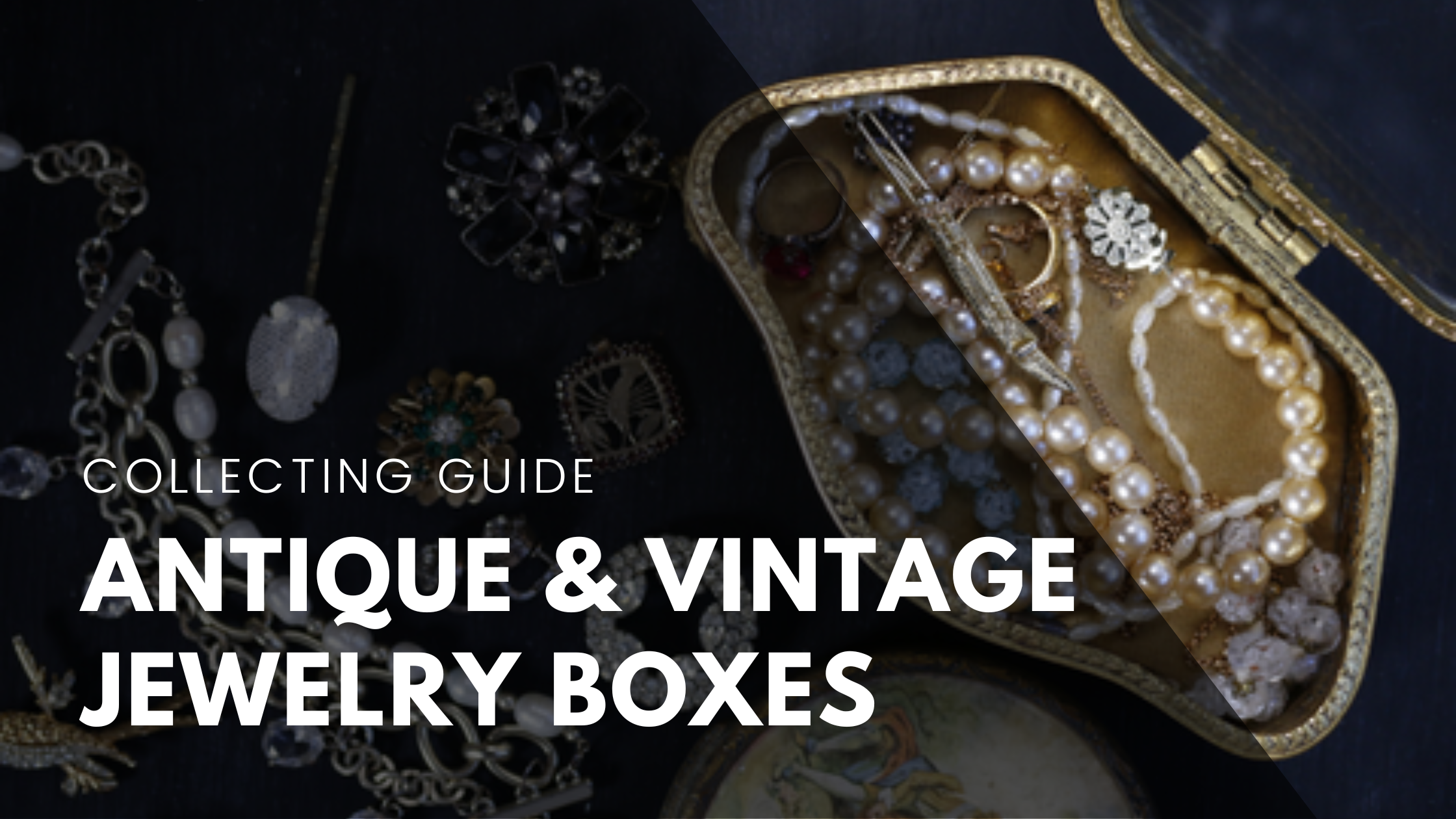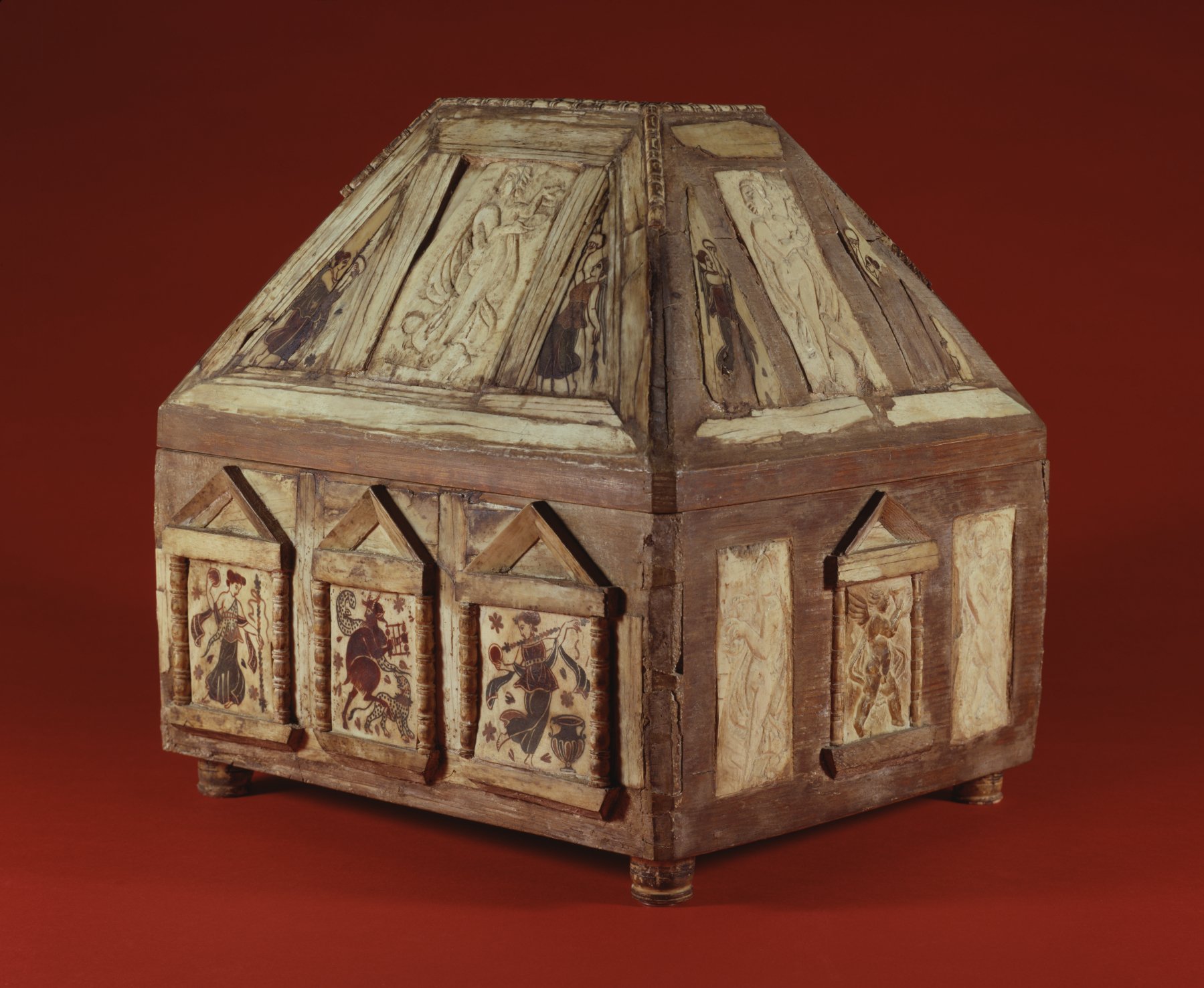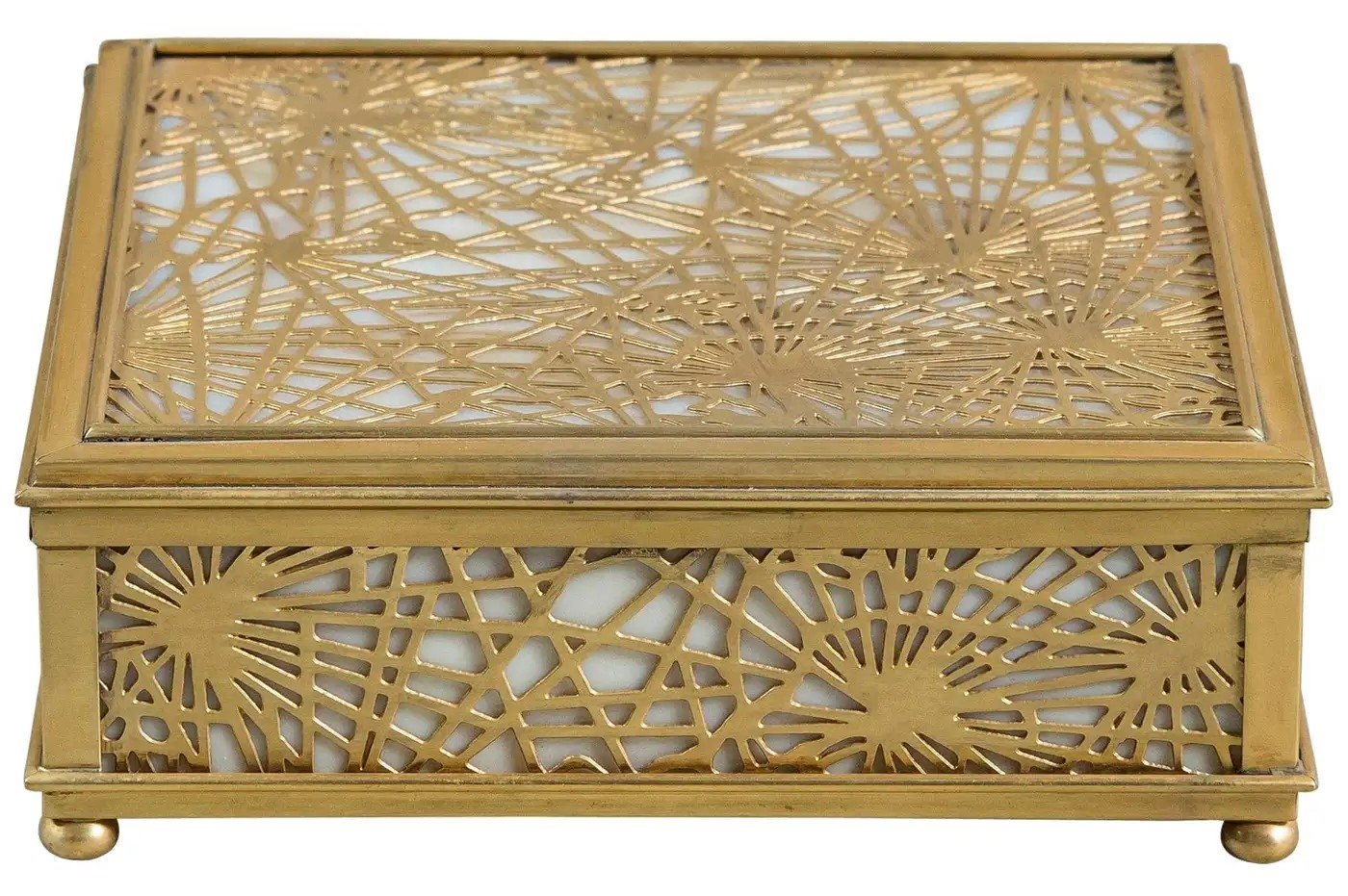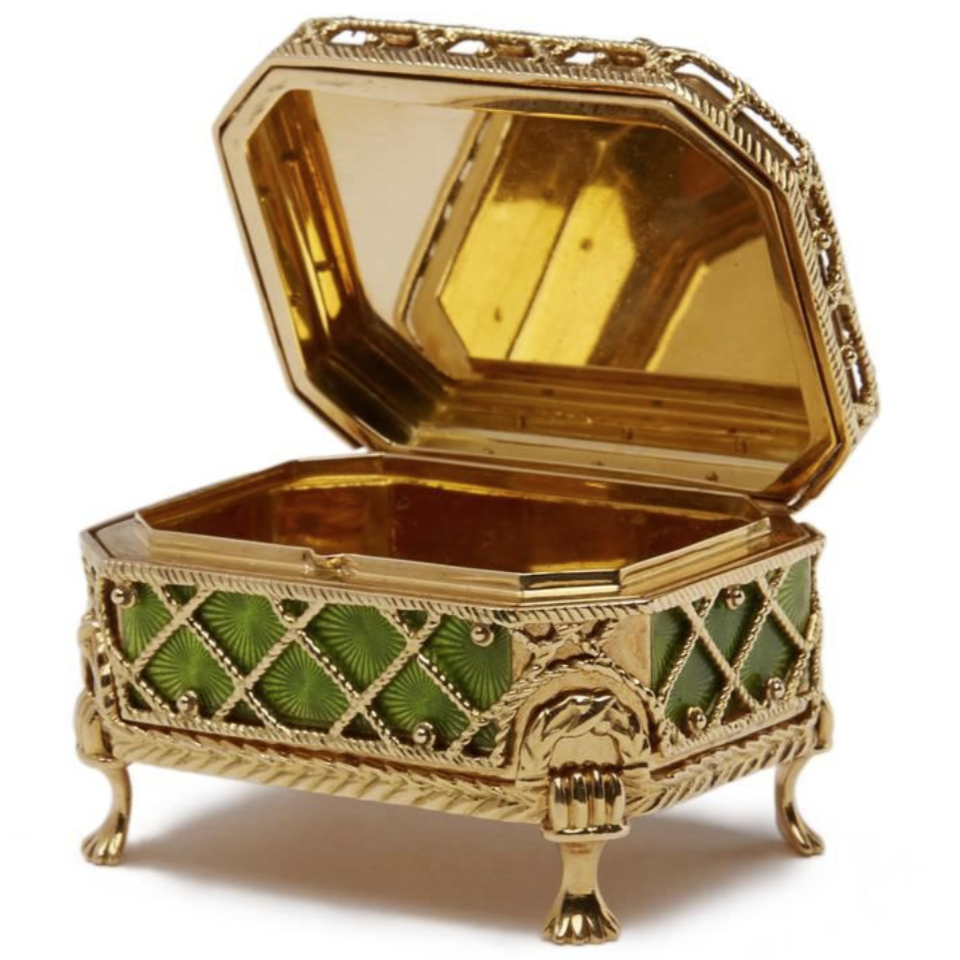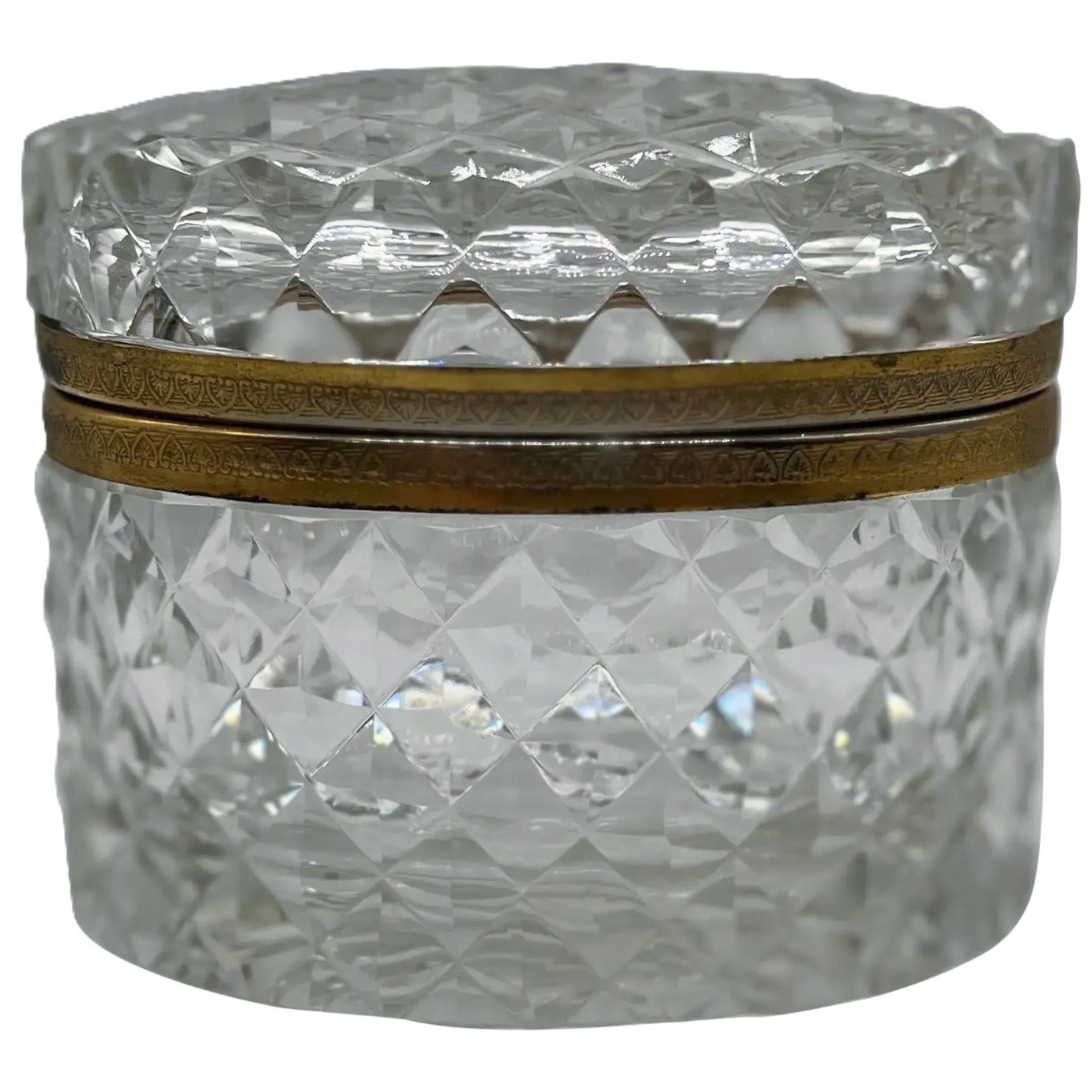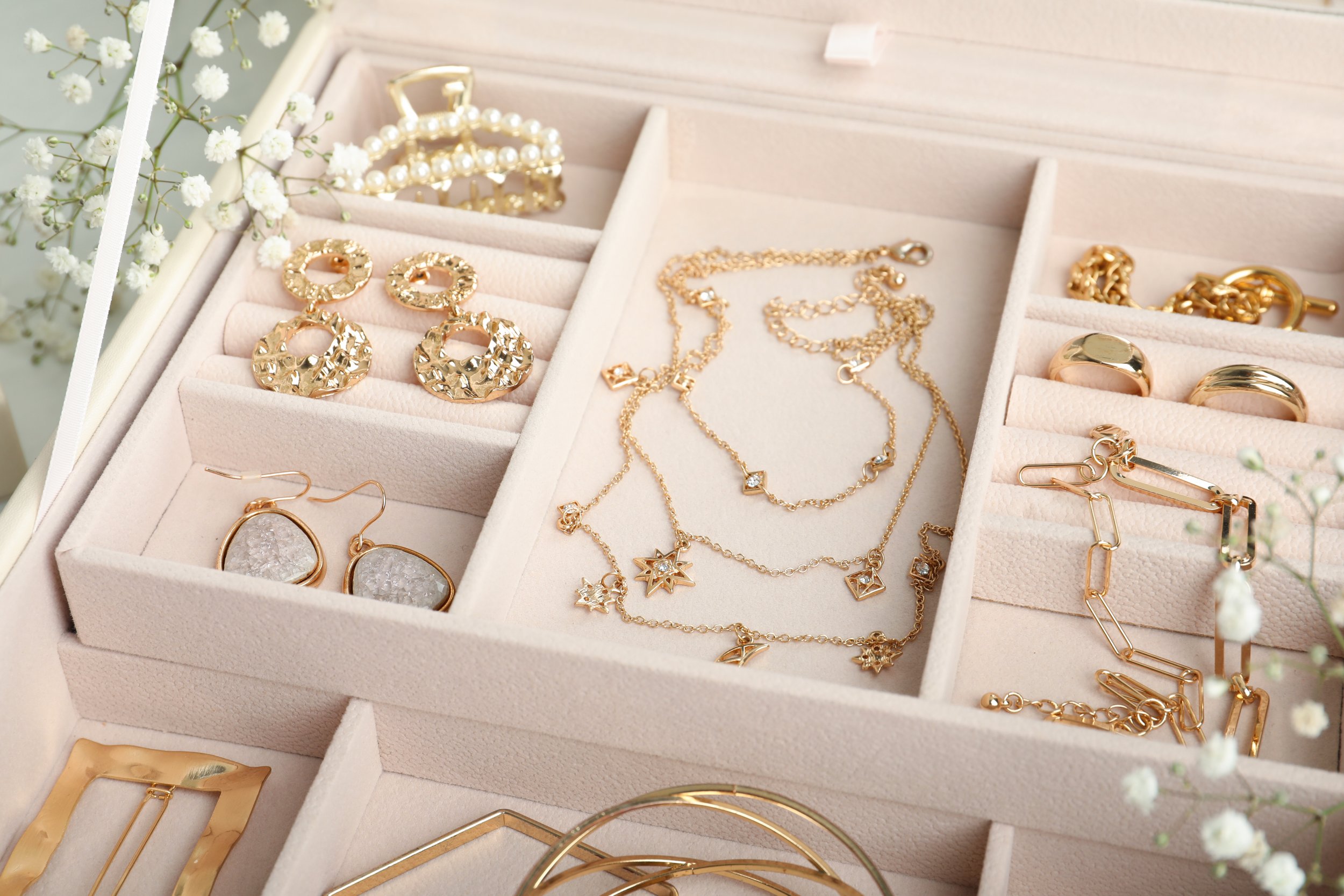Unveiling Elegance: The History and Collectibility of Jewelry Boxes
Jewelry lovers like us take pride in preserving our favorite pieces to last a lifetime and be cherished by future generations. A safe and secure place to store your jewelry is crucial for maintaining its original condition. While jewelry storage methods may vary based on personal preference, jewelry boxes have an undeniable charm, making them one of the most common ways to store and protect treasured items.
Origins and Evolution
Jewelry boxes have evolved in shape, size, and materials used in their construction. Once referred to as "jewelry caskets," these boxes resembled small treasure chests. However, one thing remains constant - intricately designed jewelry boxes always contain stunning pieces, regardless of the era.
Jewelry Box with Dancers and Faun, 4th-6th Century via The Walters Art Museum
Ancient Beginnings
The concept of storing jewelry and precious items dates back to ancient civilizations like Egypt, Mesopotamia, and China. Early jewelry boxes were often made of wood, bone, or metal and featured intricate designs and craftsmanship.
Medieval and Renaissance Periods
During the medieval and Renaissance periods, jewelry boxes became more ornate and elaborate. They were often handcrafted from wood and adorned with intricate carvings, inlays, and sometimes even jewels. These boxes were typically reserved for royalty and the upper class.
18th and 19th Centuries
As craftsmanship and design flourished in the 18th and 19th centuries, jewelry boxes became more accessible. These boxes were made in various styles, including Rococo, Baroque, and Victorian, and often featured velvet-lined interiors to protect delicate jewelry.
Tiffany Art Deco Jewelry Box
Art Nouveau and Art Deco Eras
The Art Nouveau and Art Deco movements in the late 19th and early 20th centuries influenced jewelry box design. Art Nouveau boxes featured flowing, organic forms, while Art Deco boxes embraced geometric shapes and streamlined designs.
Mass Production and Modern Times
With the advent of mass production in the 20th century, jewelry boxes became more affordable and accessible to a broader audience. Materials like plastics, metals, and faux leather were used in addition to traditional wood. Some vintage mid-century modern jewelry boxes are highly collectible today.
Materials and Craftsmanship
Jewelry boxes are crafted from various materials, each offering unique qualities and aesthetics. Wood, with its natural warmth and versatility, is a popular choice for jewelry boxes, often featuring intricate marquetry or inlay work that adds depth and texture to the design. Metal jewelry boxes from brass, silver, or gold boast durability and elegance, often adorned with intricate engravings or filigree details.
Glass jewelry boxes exude a sense of sophistication, allowing the contents to be displayed while providing protection. These boxes may feature delicate hand-painted designs or intricate etched patterns, adding a touch of artistry to the piece. Porcelain jewelry boxes, known for their delicate beauty, showcase hand-painted motifs or intricate sculptural details, making them functional and decorative.
In addition to these materials, jewelry boxes crafted from precious metals like silver or gold are prized for their luxurious appeal and heirloom quality. These boxes may feature intricate detailing and embellishments, such as gemstone accents or detailed filigree work, making them exquisite art pieces in their own right.
Overall, the craftsmanship and decorative techniques employed in creating jewelry boxes vary widely, reflecting the rich diversity of styles and materials used in their construction. Whether adorned with hand-painted designs, intricate engravings, or sculptural details, jewelry boxes are not only functional storage solutions but also cherished works of art that enhance the beauty of any collection.
Symbolism and Significance:
Jewelry boxes have historically held symbolic significance, representing more than just a functional storage solution for precious accessories. They often serve as heirloom pieces, passed down through generations, carrying the memories and stories of their previous owners. As such, they symbolize continuity, tradition, and the bonds of family and heritage.
In addition to their role as family heirlooms, jewelry boxes have also been romanticized as tokens of affection and love. In many cultures, gifting a jewelry box symbolizes devotion and commitment, with the recipient cherishing the jewelry within and the sentiment behind the gift. Presenting a jewelry box is often imbued with meaning, signifying a desire to protect and preserve the precious items contained within and the relationship itself.
The symbolism of jewelry boxes extends beyond personal relationships to encompass broader cultural and societal meanings. In some regions and periods, jewelry boxes were associated with status and wealth, serving as status symbols for the elite. In others, they were seen as symbols of femininity and beauty, with ornate designs and intricate detailing reflecting societal ideals of femininity and grace.
Throughout history, jewelry boxes have also been imbued with religious and spiritual significance, serving as vessels for sacred relics, amulets, or talismans believed to possess protective or healing properties. In this context, jewelry boxes were revered as holy objects, safeguarding precious artifacts and connecting individuals to their spiritual beliefs and traditions.
The symbolism and significance of jewelry boxes vary widely across different cultures and periods, reflecting the diverse meanings and associations attributed to these cherished objects. Whether as symbols of family heritage, tokens of love and affection, or representations of status and spirituality, jewelry boxes continue to hold a special place in the hearts and minds of people worldwide.
Collectibility and Rarity:
In recent years, enthusiasts and collectors have noticed a noticeable surge in interest in collecting vintage and antique jewelry boxes. This growing fascination can be attributed to several factors, each contributing to the allure and collectability of these timeless treasures.
Age: Vintage and antique jewelry boxes often hold appeal due to their age and historical significance. As artifacts of the past, these boxes provide a tangible connection to bygone eras, offering glimpses into the craftsmanship, design aesthetics, and societal norms of the periods in which they were created.
Rarity: The rarity of vintage and antique jewelry boxes adds to their allure for collectors. As time passes, many of these pieces become increasingly scarce, with particular designs or styles becoming highly sought after due to limited production runs or discontinued manufacturing practices.
Craftsmanship: Vintage and antique jewelry boxes are admired for their exquisite craftsmanship and attention to detail. From intricate wood carvings to delicate metalwork, these boxes showcase the skill and artistry of the artisans who created them. Collectors are drawn to the fine craftsmanship displayed in these pieces, appreciating the time and effort invested in their creation.
Provenance: The provenance of vintage and antique jewelry boxes can significantly impact their collectability. Boxes with well-documented histories, proven ownership by notable individuals, or associations with renowned artisans or manufacturers often command higher prices and garner greater interest among collectors.
Historical Significance: Vintage and antique jewelry boxes are valued not only for their aesthetic appeal but also for their historical significance. Some boxes are linked to specific historical events, cultural movements, or periods of artistic innovation, adding layers of meaning and context to their collectability.
Overall, the growing interest in collecting vintage and antique jewelry boxes can be attributed to a combination of factors: age, rarity, craftsmanship, provenance, and historical significance. As collectors continue to seek out these timeless treasures, the appreciation for their beauty and historical value only grows.
Styles and Designs
Jewelry boxes come in various styles and designs, each reflecting the tastes and aesthetics of different periods and cultural influences. From ornate Victorian caskets to sleek modern-century designs, these boxes showcase various styles and motifs catering to varying preferences and tastes. Let's explore some of the popular design motifs and themes found in jewelry boxes:
Victorian Elegance: Victorian-era jewelry boxes are known for their ornate and elaborate designs, featuring intricate carvings, delicate filigree work, and embellishments such as pearls, cameos, and floral motifs. These boxes often evoke a sense of romance and nostalgia with their richly detailed craftsmanship and vintage charm.
Art Deco Sophistication: Art Deco jewelry boxes are characterized by their bold geometric shapes, sleek lines, and glamorous materials such as mirrored surfaces, chrome accents, and exotic woods. Inspired by the 1920s and 1930s modernist movement, Art Deco designs often feature striking geometric patterns, sunburst motifs, and stylized animal prints that embody sophistication and luxury.
Mid-Century Simplicity: Mid-century modern jewelry boxes are celebrated for their minimalist design aesthetic, clean lines, and organic forms. Influenced by the Bauhaus movement and Scandinavian design principles, these boxes prioritize function and simplicity, often featuring sleek wooden constructions, minimalist hardware, and understated finishes.
Rococo Opulence: Rococo-style jewelry boxes are characterized by their lavish and ornamental designs, featuring elaborate scrollwork, intricate floral motifs, and whimsical details such as cherubs and scalloped edges. Inspired by the opulent designs of the 18th-century French court, Rococo boxes exude a sense of luxury and grandeur with their intricate detailing and sumptuous materials.
Asian-inspired Elegance: Jewelry boxes inspired by Asian design motifs often feature delicate lacquer work, intricate inlay patterns, and motifs such as cherry blossoms, dragons, and pagodas. These boxes embody a sense of serenity and elegance with their graceful lines, harmonious proportions, and rich cultural symbolism.
Overall, jewelry boxes come in diverse styles and designs, each offering a unique expression of craftsmanship, cultural influences, and design aesthetics. Whether ornate and elaborate or sleek and minimalist, these boxes serve as functional storage solutions and beautiful decorative accents for showcasing cherished jewelry pieces.
Famous Makers and Brands
Renowned jewelry box makers and brands have left an indelible mark on the art and craftsmanship of jewelry boxes, each bringing their unique style, innovation, and expertise to the craft. Let's explore some of the most celebrated makers and brands throughout history:
Tiffany & Co.: Founded in 1837 by Charles Lewis Tiffany, Tiffany & Co. is renowned for its exquisite craftsmanship and timeless designs. The company's jewelry boxes are coveted for iconic blue packaging, elegant designs, and attention to detail. Tiffany & Co. jewelry boxes often feature luxurious materials such as sterling silver, fine woods, and sumptuous velvet linings, making them treasured keepsakes for storing precious jewelry.
Fabergé: Founded in 1842 by Gustav Fabergé, the House of Fabergé is synonymous with luxury, opulence, and exquisite craftsmanship. Fabergé jewelry boxes are celebrated for their intricate designs, meticulous enameling, and lavish use of precious gemstones and metals. These boxes often feature elaborate motifs such as flowers, animals, and mythological figures, reflecting the rich artistic heritage of the brand.
Cartier: Founded in 1847 by Louis-François Cartier, Cartier is renowned for its innovative designs, exceptional craftsmanship, and timeless elegance. Cartier jewelry boxes are coveted for their sleek and sophisticated designs, often featuring the brand's iconic red packaging and signature logo. These boxes are crafted from high-quality leather, wood, and precious metals, reflecting the brand's commitment to luxury and refinement.
Meissen: Founded in 1710 by Augustus the Strong Elector of Saxony, the Meissen Porcelain Manufactory is renowned for its exquisite porcelain creations. Meissen jewelry boxes are celebrated for their stunning hand-painted designs, intricate detailing, and fine craftsmanship. These boxes often feature delicate floral motifs, scenic landscapes, and elaborate figurative designs, showcasing the brand's mastery of the porcelain art form.
Baccarat: Founded in 1764 in France, Baccarat jewelry boxes are coveted for their exquisite glass crystal craftsmanship, intricate cuts, and luxurious designs. These boxes often feature intricate patterns, faceted surfaces, and the brand's iconic logo, making them treasured pieces for storing precious jewelry.
Overall, renowned jewelry box makers and brands such as Tiffany & Co., Fabergé, Cartier, Meissen, and Baccarat have significantly contributed to the art and craftsmanship of jewelry boxes, creating timeless treasures cherished for their beauty, elegance, and craftsmanship.
Care and Maintenance
Caring for and maintaining vintage and antique jewelry boxes is essential to preserve their beauty and integrity for future generations. Here are some practical tips to help you care for your precious heirlooms:
Cleaning: Use a soft, dry cloth to gently wipe away dust and dirt from the surface of the jewelry box. For stubborn stains or grime, dampen the fabric with a mild soap solution and gently wipe the affected areas. Avoid using harsh chemicals or abrasive cleaners, as they can damage the delicate finishes of vintage jewelry boxes.
Polishing: For metal jewelry boxes, such as those made of silver or brass, use a specialized metal polish to restore shine and luster. Apply the polish with a soft cloth, following the manufacturer's instructions carefully. Use high-quality wood polish or wax to nourish and protect the wood surface for wooden jewelry boxes.
Storage: Store your vintage and antique jewelry boxes in a cool, dry place away from direct sunlight and moisture. Avoid placing heavy objects on top of the boxes, as this can cause damage to the delicate materials and finishes. Consider lining the storage area with acid-free tissue paper to protect the boxes from scratches and abrasions.
Handle with care: When handling vintage and antique jewelry boxes, always use gentle and careful movements to avoid damaging the delicate materials and components. Avoid placing undue pressure on hinges, clasps, or handles, as they may be fragile and prone to breakage.
Professional restoration: If your vintage or antique jewelry box requires more extensive restoration, consider consulting a professional restorer or conservator. They have the expertise and specialized tools to carefully repair and restore damaged jewelry boxes while preserving their original beauty and integrity.
By following these practical tips for caring for and maintaining vintage and antique jewelry boxes, you can ensure that these precious heirlooms remain beautiful and cherished for many years.
Buying and Collecting Tips
When buying and collecting vintage and antique jewelry boxes, it's essential to consider several factors to ensure you're getting a quality piece that meets your preferences. Here are some tips and advice to help you in your pursuit:
Research Makers: Before purchasing, research the makers and brands of vintage and antique jewelry boxes. Learn about renowned manufacturers and artisans known for their quality and craftsmanship. Look for identifying marks or signatures on the boxes, such as maker's marks or hallmarks, to authenticate their origin.
Evaluate Condition: Carefully evaluate the condition of the jewelry box before buying. Look for signs of wear, damage, or restoration, such as scratches, dents, cracks, or missing parts. Assess the functionality of hinges, clasps, and drawers to ensure they operate smoothly. Remember that minor wear and patina are expected in vintage pieces and can add character and charm.
Consider Provenance: Consider the provenance or history of the jewelry box, if available. Provenance can provide valuable insights into the box's previous ownership, use, and historical significance. Look for documentation, such as receipts, certificates of authenticity, or previous owner's notes, that attest to the box's authenticity and provenance.
Explore Resources: Explore various resources and avenues for acquiring vintage and antique jewelry boxes. Visit antique shops, flea markets, estate sales, and specialty vintage stores to browse their selections. Attend antique fairs, auctions, and exhibitions where you can find various jewelry boxes from different periods and styles. Additionally, explore online marketplaces, auction websites, and online antique stores for a convenient way to shop for vintage pieces from the comfort of your home.
Build Relationships: Build relationships with reputable dealers, collectors, and vintage and antique jewelry box experts. Seek advice and guidance from experienced collectors and dealers who can offer valuable insights and recommendations. Attend collector's clubs, workshops, and seminars to network with fellow enthusiasts and expand your knowledge of jewelry box collecting.
Following these tips and advice, you can make informed decisions when buying and collecting vintage and antique jewelry boxes and build a curated collection that reflects your style and appreciation for craftsmanship and history.
Whether you're a seasoned collector or a novice enthusiast, exploring the world of vintage and antique jewelry boxes offers a glimpse into the past and an appreciation for fine craftsmanship and design. So, take the opportunity to delve into this fascinating world and discover the timeless treasures waiting to be admired and cherished.

